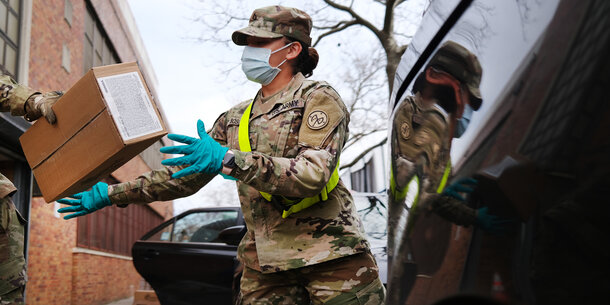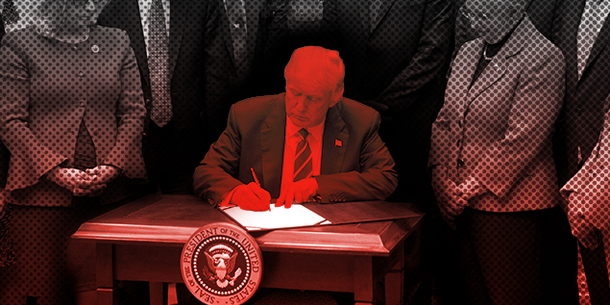This piece originally appeared in the Boston Globe.
President Trump has been hinting for days that he will deploy federal troops to suppress the protests that have erupted across the country in response to the horrific death of George Floyd under the knee of a Minneapolis police officer. Monday, he took his threats from Twitter to the Rose Garden. “If a city or state refuses to take the actions that are necessary to defend the life and property of their residents,” he warned, “then I will deploy the United States military and quickly solve the problem.”
State officials and media commentators reacted with alarm, accusing the president of overreach. The response is understandable. The domestic use of federal troops is deeply at odds with modern practice and sensibilities. It is easier to believe that this is just another instance of Trump laying claim to powers he doesn’t have.
This time, though, the law might be on his side. Over two centuries ago, Congress passed a statute giving the president broad authority to deploy the military in response to civil unrest. The authority is rarely used, however — and for good reason. Even under the most responsible command, injecting military forces into a domestic crisis has the potential to make a bad situation worse. Under Trump, it could be disastrous.
The law, known as the Insurrection Act, dates back to 1807. Under its broadest section, the president may deploy troops to suppress “any insurrection, domestic violence, unlawful combination, or conspiracy” if it impairs the execution of state or federal law. He may do so with or without the request of a state’s governor, and he may deploy active duty armed forces or federalize the National Guard.
At first blush, the Insurrection Act might seem to contradict “posse comitatus” — the principle that the military should not engage in domestic law enforcement. That principle is deeply embedded in our nation’s history. And yet it does not appear in the Constitution. In fact, the Constitution makes clear that Congress can authorize the deployment of the militia “to execute the Laws of the Union, suppress Insurrections and repel Invasions.”
Even the Posse Comitatus Act, passed by Congress in 1878, does not entirely bar military participation in law enforcement. It prohibits such participation “except in cases and under circumstances expressly authorized by the Constitution or Act of Congress.” The Insurrection Act provides that express authorization.
Despite its permissiveness, the Insurrection Act has been used infrequently in modern times. It was last invoked in 1992, when President George H.W. Bush deployed armed forces at the request of Governor Pete Wilson of California to help curb violence that erupted in Los Angeles after the police beating of Rodney King.
Why the reticence in using this law? Simply, Americans don’t like the idea of armored tanks rolling into their cities. It smacks of authoritarianism; it goes against our values and our national self-concept. And so, even in cases where the Insurrection Act might provide a legal opening — for instance, in the chaotic aftermath of Hurricane Katrina — the fear of political blowback has been enough to stop presidents from exploiting it.
Moreover, using the military to suppress civil unrest can actually escalate violence. As badly as many police officers have behaved during the recent protests, they are at least nominally tasked with protecting the communities they serve. Military troops have no such mission or training. Their goal is to take down the enemy, and the enemy rarely has constitutional rights. As one member of the Minnesota National Guard told a reporter, “We’re a combat unit not trained for riot control or safely handling civilians in this context.”
In theory, the commander in chief could take steps to mitigate these inherent dangers. He could clearly and consistently communicate — both to the troops and to the American people — that the domestic mission is to protect, not to subdue. He could emphasize that we are not at war, and that military forces must scrupulously honor the constitutional rights of every person with whom they come into contact.
Instead, Trump has openly reveled in the prospect of using force against the protesters. “When the looting starts, the shooting starts,” he tweeted. He also tweeted that any protester who breached the White House fence “would have been greeted with the most vicious dogs, and most ominous weapons, I have ever seen. That’s when people would have been really badly hurt, at least.” Far from wanting to avoid violent clashes with civilians, the president seems to be spoiling for one.
Of course, this could all prove to be more show than substance. The president has threatened many times to intervene in the states’ handling of the coronavirus pandemic. Ultimately, he has opted to criticize certain (Democratic) governors from the sidelines rather than assuming responsibility for the response — and, in turn, the outcomes — in those states. The same could well be true here. Cities burning in states governed by Democrats make better fodder for Trump’s Twitter feed than cities burning under his own command and control.
Nonetheless, it would be a mistake to dismiss the president’s comments as mere bluster. The law gives him significant authority to carry through on his threats. If he does so, armed forces could become a domestic police force, captained by a president who has encouraged police officers to be “rough” with suspects and who claims that Article II of the Constitution “allows me to do whatever I want.” In a time already fraught with unprecedented dangers, it’s hard to imagine a more dangerous state of affairs.



